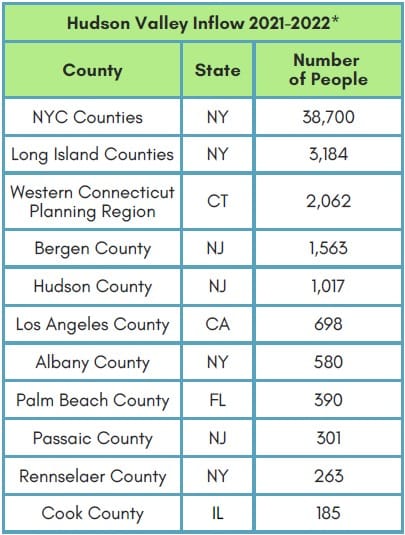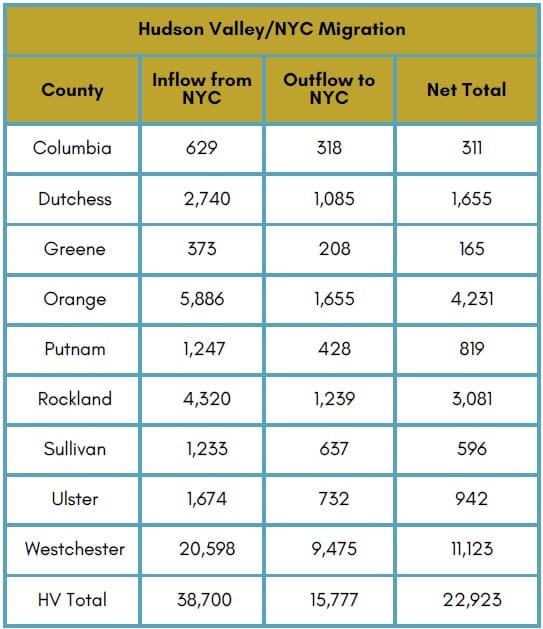OneKey MLS Expects Strong Q1 2026 Returns from November's Robust Price Growth and Surge in Pending Sales
Pending sales, especially the 5% jump across all property types, show buyers gaining confidence.
Data shows that from 1996-2021, the Hudson Valley region lost a net total of 146,763 people to out migration, which calculates out to 5% of the Hudson Valley’s population.

NEWBURGH—Hudson Valley Pattern for Progress issued a scathing report earlier today (July 15) on the high cost of out migration taking place in New York State and the Hudson Valley region, which it said was one of the worst in a quarter century.
The Newburgh-based non-profit’s report noted that the nine-county Hudson Valley region (Columbia, Dutchess, Greene, Orange, Putnam, Rockland, Sullivan, Ulster and Westchester counties) lost a net of 12,257 people who moved to other counties or states in 2021. The report stated: “As the pandemic cooled and people tip-toed back toward normality, the Hudson Valley experienced some of its worst population losses due to migration in the past 25 years." The study noted that the 2021 population loss was the largest since 2005, a year that saw thousands move from the Hudson Valley to New York City as part of the post 9-11 return to the New York metropolitan area. Pattern for Progress states that the Hudson Valley lost a net of $1.1 billion in adjusted gross incomes due to outward migration in 2021.
The report entitled: “Moving In, Moving Out” cited data released by the U.S. Internal Revenue Service in late June 2024 that tracked the movement of people from state to state and county to county from 2022 and earlier.

Data shows that from 1996-2021, the Hudson Valley region lost a net total of 146,763 people to out-migration, which calculates out to 5% of the Hudson Valley’s population.
Statewide, federal data indicated that New York State lost a net of 224,781 people to out-migration in 2021, which represented approximately $14.2 billion in lost adjusted gross income.
Pattern’s report noted that the period of 2021 and the start of 2022 was a time of transition during the COVID-19 pandemic, where vaccines were being administrated in large numbers and mask mandates were beginning to be lifted, while remote work policies were implemented in large numbers.
Adam Bosch, president and CEO of Hudson Valley Pattern for Progress, tells Real Estate In-Depth that the migration trend of northern parts of the Hudson Valley region gaining in population and the southern section of the region losing residents continues. He added that many new residents of the northern Hudson Valley have incomes that are greater than those that are leaving the Hudson Valley.
While that may have some beneficial impacts, it will also lead to less police, fire, municipal and construction workers in the Hudson Valley.
Another troubling trend is that the loss of population in the Hudson Valley has resulted in approximately 45,000 fewer children in the region’s public schools as compared to 2005. In that span of nearly two decades, more than 40 school buildings have closed, the report notes.
In addition, the outward migration has reduced the size of the area’s workforce and increased the age of the average worker. The older half of the labor pool (45-64) currently outnumbers the younger contingent by almost 100,000 people.

“These workforce and youth trends indicate that our labor pool is likely to shrink by at least 125,000 people in the next 10-20 years, a troubling trend that could be exacerbated if outward migration persists,” the report notes.
Those demographics have and will likely cause strains in the blue-collar workforce and service industries in the region. Another issue impacting the middle class in the Hudson Valley is the escalating cost of housing.
“Realtors and banks say that approximately 20% of home purchases in the Hudson Valley during the heart of the pandemic were all-cash transactions,” the Pattern report states. “These trends have broad ramifications. Homeownership is now unaffordable for most Hudson Valley households because prices increased more and faster than wages. That has put additional stress on our limited rental stock.”
The report continued, “Our inadequate pace of development has not kept up with demand. Migration patterns in the near future could worsen these problems or help to alleviate them.”
Hudson Valley Pattern for Progress is scheduled to release its analysis of housing affordability entitled “Out of Reach” on Tuesday. Look for further coverage in Real Estate In-Depth.
Receive original business news about real estate and the REALTORS® who serve the lower Hudson Valley, delivered straight to your inbox. No credit card required.